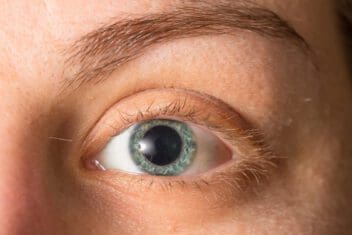
Medically Reviewed by Angelique J. Pillar, M.D. NVISION Surgeon
Determining Safe Ways to Remove a Conjunctival Cyst
Last Updated:

Medically Reviewed by Angelique J. Pillar, M.D. NVISION Surgeon
A conjunctival cyst is a fluid-filled sac that forms on the outer layer of your eye, the conjunctiva. It can form for a variety of reasons, including ongoing inflammation, trauma, or surgery on the eye.
One of the ways to get rid of a conjunctival cyst on the eyeball is to drain it. Typically, to keep the cyst from coming back, the cyst will need to be removed completely through a surgical procedure.
Surgery is usually a minor outpatient procedure that is often done with the assistance of a laser. Laser surgery is fast, effective, minimally invasive, and a safe way to remove a conjunctival cyst completely.
Conjunctival cysts will often go away on their own. Your doctor can determine if you need a surgical intervention or if there are techniques that can help you cope while the cyst clears up on its own.
Aspiration

Since a cyst is a sac that is filled with fluid, it can be drained through a procedure called aspiration. This procedure is typically a same-day intervention that uses topical anesthetic.
A needle is used to drain the cyst, and this can be an effective way to get rid of a small conjunctival cyst. There are often no reported complications, and this can be enough to keep the cyst from returning.
You deserve clear vision. We can help.
With 135+ locations and over 2.5 million procedures performed, our board-certified eye surgeons deliver results you can trust.
Your journey to better vision starts here.
When cysts are bigger, a surgical option is usually recommended.
Surgical Options
In order to completely remove a conjunctival cyst and keep it from coming back, surgery that completely and carefully removes the cyst intact is often recommended.
There are several surgical methods that can safely and completely remove a conjunctival cyst.
- Surgical excision, often using staining dye: Complete removal of a conjunctival cyst on the eyeball through traditional surgical means will often use a dye to stain the tissue. This allows the surgeon to see all the margins of the cyst so they can remove it all at once and in one piece. This option is considered effective and simple.
- Injection of a sclerosing agent with aspiration: Along with aspiration, sclerotherapy can be used as a minimally invasive surgical procedure to completely remove a conjunctival cyst. Reports show no ocular complications or significant swelling; therefore, this procedure is considered safe and effective.
- Laser-assisted excision: Several different types of lasers have been used to help excise conjunctival cysts. Lasers are often less invasive and more precise than traditional surgical tools. The YAG laser can be used to rupture the cyst, while the argon laser is used for photoablation. Newer lasers like the pattern scan laser (PASCAL) can also be used in an office setting, which allow patients to experience less pain due to less time needed to pulse the laser. Overall, the PASCAL laser-assisted procedure has been proven to be effective and safe in the removal of conjunctival cysts.
- Atmospheric low-temperature plasma (ALTP): Novel ways of removing conjunctival cysts have recently been published. The plasma-based approach uses an atmospheric low-temperature plasma (ALTP) directly on the cyst to remove the fluid. Then, the ALTP is applied to areas around the cyst, which can help ensure that the cyst will not come back. This is important as cyst recurrence is one of the main complications of surgical removal. This often occurs because not all of the cyst was removed.Studies published in the journal Clinical Ophthalmology report that the ALTP approach can be less expensive, more effective, simple, office-based, and a minimally invasive way of safely removing a conjunctival cyst.
Management of a Cyst Without Surgical Intervention

Often, a conjunctival cyst will not need treatment or a surgical intervention. It can clear up completely on its own.
Conjunctival cysts on the eyeball are usually small and may not cause any symptoms. When this is the case, a doctor will often recommend using some coping methods to manage the cyst. This allows you to live with it temporarily to see if it will clear up without a more invasive treatment.
Lubricating eye drops like artificial tears can help if you are experiencing irritation or dry eyes. Your doctor can also prescribe short-term steroid eye drops to manage inflammation and keep the cyst from getting any bigger. Cold compresses can help with discomfort as well.
The type, severity, and cause of your conjunctival cyst will play a role in what is the best treatment option for you. A conjunctival cyst can make it feel like you have something in your eye and also make it difficult to open and close your eyelid.
When a conjunctival cyst on the eyeball is impairing your quality of life, it is time to seek out a medical intervention. Surgery for removing a conjunctival cyst is generally minor and minimally invasive, performed as a same-day in-office procedure.
Talk with your doctor about your situation, so you can determine the best and safest way to manage or remove your conjunctival cyst.
You deserve clear vision. We can help.
With 135+ locations and over 2.5 million procedures performed, our board-certified eye surgeons deliver results you can trust.
Your journey to better vision starts here.
References
- Growing Pains. (March 2018). Review of Optometry.
- Clinical Study of Histological Proven Conjunctival Cysts. (April-June 2015). Saudi Journal of Ophthalmology.
- Long-Term Results of Surgical Excision of Conjunctival Retention Cyst Using Trypan Blue and Methylcellulose. (June 2019). American Journal of Ophthalmology Case Reports.
- Conjunctival Retention Cysts: Outcomes of Aspiration and Sclerotherapy With Sodium Tetradecyl Sulfate. (March/April 2019). Ophthalmic Plastic and Reconstructive Surgery.
- Conjunctival Cystectomy Assisted by Pattern Scan Laser Photocoagulation. (July 2017). Military Medical Research.
- A Novel Approach to Treatment of Conjunctival Cyst Ablation Using Atmospheric Low-Temperature Plasma. (August 2020). Clinical Ophthalmology.

Angelique J. Pillar, MD is a fellowship trained and board certified ophthalmologist specializing in cataract, cornea, and refractive surgery.
This content is for informational purposes only. It may have been reviewed by a licensed physician, but is not intended to serve as a substitute for professional medical advice. Always consult your healthcare provider with any health concerns. For more, read our Privacy Policy and Editorial Policy.
